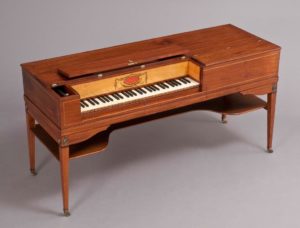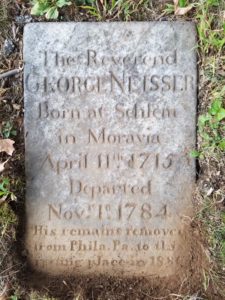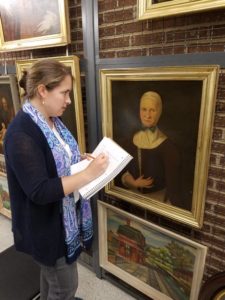Uncovering Philadelphia’s German History
EMERGING SCHOLARS > SUMMER RESEARCH GRANTS
By LISA MINARDI,
History of American Civilization, University of Delaware
My dissertation, Germans in the Quaker City: Ethnicity, Religion, and Material Life in Early Philadelphia, seeks to resurrect the forgotten story of Philadelphia’s early German-speaking community, who comprised some 45% of the city’s total residents in 1760 and about 33% in 1800. With support from a summer research grant from the Decorative Arts Trust, I explored the collections of several Philadelphia-area archives and museums to study both documentary and material sources for this project.
A particularly important object for my study is a mahogany piano in the collection of the Philadelphia History Museum. Made in Philadelphia by German émigré Charles Albrecht, it is dated 1789 and is the earliest known extant American-made piano. To date I have located approximately two dozen instruments made by Albrecht and am using them to explore topics such as craftsmanship, patronage, and the role of music within Philadelphia German homes and churches at the turn of the 19th century.
At the Moravian Archives in Bethlehem, the voluminous records of the Philadelphia Moravian church contain items such as annual membership lists and a 1730s day book kept by a Philadelphia storekeeper, which documents both a wide range of goods and a diverse clientele, including Quakers, Anglicans, Lutherans, Mennonites, and others. I also examined these documents as artifacts, scrutinizing their bindings and paper as well as their imprints and other such clues. Of particular interest are several diaries from the Moravian congregation in Nazareth, PA, bearing the label of Philadelphia printer G. W. Mentz. These volumes help me to track the networks established by Philadelphia German printers through the Moravian community.
I also searched for objects associated with Moravian ministers in Philadelphia. The prominent reverend Georg Neisser immigrated to Philadelphia in 1740, where he was pastor of First Moravian Church until his death in 1784. Portraits of Neisser and his wife, Catharina, were painted by the Moravian artist Johann Valentin Haidt. I was struck by the clothing worn by Mrs. Neisser: a tightly fitted white cap and brown dress, both accented with a blue ribbon signifying her marital status. While this clothing was worn by many Moravian women and would not have stood out in towns such as Nazareth or Bethlehem, her attire would have contrasted dramatically in Philadelphia and instantly identified the her as Moravian.
The Moravian cemetery in Philadelphia no longer exists, with most remains moved in the 19th century. I discovered Georg Neisser’s tombstone in Bethlehem. Moravian customs are distinct even in death. The tombstones were laid flat on the ground, rather than vertical, and of a uniform shape and size. No distinctions were made for gender or rank; Rev. Neisser’s stone was virtually the same as that of a former African slave interred only a short distance away.
These discoveries made a significant impact in shaping the direction of my dissertation as I seek to uncover and interpret the everyday life of Germans living in early Philadelphia. I aim to demonstrate the importance of German-speaking people in the formation of Philadelphia’s—and ultimately America’s—complex, multiethnic, polyglot identity.
By LISA MINARDI,
History of American Civilization, University of Delaware
My dissertation, Germans in the Quaker City: Ethnicity, Religion, and Material Life in Early Philadelphia, seeks to resurrect the forgotten story of Philadelphia’s early German-speaking community, who comprised some 45% of the city’s total residents in 1760 and about 33% in 1800. With support from a summer research grant from the Decorative Arts Trust, I explored the collections of several Philadelphia-area archives and museums to study both documentary and material sources for this project.
A particularly important object for my study is a mahogany piano in the collection of the Philadelphia History Museum. Made in Philadelphia by German émigré Charles Albrecht, it is dated 1789 and is the earliest known extant American-made piano. To date I have located approximately two dozen instruments made by Albrecht and am using them to explore topics such as craftsmanship, patronage, and the role of music within Philadelphia German homes and churches at the turn of the 19th century.
At the Moravian Archives in Bethlehem, the voluminous records of the Philadelphia Moravian church contain items such as annual membership lists and a 1730s day book kept by a Philadelphia storekeeper, which documents both a wide range of goods and a diverse clientele, including Quakers, Anglicans, Lutherans, Mennonites, and others. I also examined these documents as artifacts, scrutinizing their bindings and paper as well as their imprints and other such clues. Of particular interest are several diaries from the Moravian congregation in Nazareth, PA, bearing the label of Philadelphia printer G. W. Mentz. These volumes help me to track the networks established by Philadelphia German printers through the Moravian community.
I also searched for objects associated with Moravian ministers in Philadelphia. The prominent reverend Georg Neisser immigrated to Philadelphia in 1740, where he was pastor of First Moravian Church until his death in 1784. Portraits of Neisser and his wife, Catharina, were painted by the Moravian artist Johann Valentin Haidt. I was struck by the clothing worn by Mrs. Neisser: a tightly fitted white cap and brown dress, both accented with a blue ribbon signifying her marital status. While this clothing was worn by many Moravian women and would not have stood out in towns such as Nazareth or Bethlehem, her attire would have contrasted dramatically in Philadelphia and instantly identified the her as Moravian.
The Moravian cemetery in Philadelphia no longer exists, with most remains moved in the 19th century. I discovered Georg Neisser’s tombstone in Bethlehem. Moravian customs are distinct even in death. The tombstones were laid flat on the ground, rather than vertical, and of a uniform shape and size. No distinctions were made for gender or rank; Rev. Neisser’s stone was virtually the same as that of a former African slave interred only a short distance away.
These discoveries made a significant impact in shaping the direction of my dissertation as I seek to uncover and interpret the everyday life of Germans living in early Philadelphia. I aim to demonstrate the importance of German-speaking people in the formation of Philadelphia’s—and ultimately America’s—complex, multiethnic, polyglot identity.



